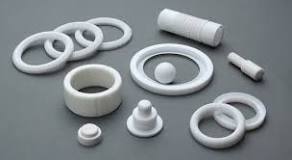PTFE, or Polytetrafluoroethylene, is a remarkable material known for its exceptional properties and wide range of applications. PTFE has become integral to our modern lives, from non-stick cookware to electrical insulation. This article will explore the history and advancements in PTFE fiber and polymer, exploring how this versatile material has evolved.

The Origins of PTFE
The story of PTFE began in 1938 when a chemist named Dr. Roy Plunkett accidentally discovered the substance while working on refrigerants at DuPont’s Jackson Laboratory in New Jersey. During an experiment involving tetrafluoroethylene gas (TFE), Plunkett noticed that the gas had solidified within his container. Upon further investigation, he realized he had stumbled upon a new polymer with unique properties.
This accidental discovery marked the birth of Polytetrafluoroethylene or PTFE. This substance would revolutionize various industries due to its exceptional characteristics.
Properties and Applications
1. Non-Stick Coating
One of the most well-known properties of PTFE is its non-stick nature. This property arises from its low surface energy, which allows substances to slide off its surface easily without sticking. It paved the way for non-stick cookware such as Teflon pans and baking sheets.
2. Chemical Resistance
PTFE exhibits remarkable chemical resistance against acids, bases, solvents, and other corrosive substances. This property is ideal for chemical processing equipment such as piping systems, gaskets, seals, and valves.
3. Electrical Insulation
Due to its excellent dielectric properties and high melting point stability, PTFE is widely used as electrical insulation in various industries. It can withstand high voltages and is commonly found in cables, connectors, and insulating tapes.
4. Low Friction
PTFE possesses an extremely low coefficient of friction, making it highly suitable for applications where reduced friction is desired. It is utilized in bearings, gears, and sliding components to minimize wear and improve efficiency.
5. Heat Resistance
PTFE exhibits exceptional heat resistance with a melting point of around 327 degrees Celsius (621 degrees Fahrenheit). This property can withstand high temperatures without significantly changing its physical or chemical structure.
Advancements in PTFE Fiber
Over the years, researchers have significantly advanced in developing PTFE fibers with enhanced properties and performance characteristics.
1. Expanded Polytetrafluoroethylene (ePTFE)
Expanded Polytetrafluoroethylene (ePTFE) is a unique form of PTFE stretched to create a porous structure with millions of tiny interconnected pores. This material retains PTFE’s inherent properties while offering improved breathability and water resistance.
ePTFE finds applications in various fields, such as medical textiles (for surgical implants), outdoor clothing (as waterproof membranes), air filtration systems, and even as membranes for fuel cell technology.
2. High-Strength Fibers
Advancements have also been made to enhance PTFE fibers’ strength and tensile properties by introducing reinforcements or blending them with other materials such as carbon fiber or glass fiber. These high-strength fibers find applications requiring increased mechanical strength, such as aerospace components or industrial belting systems.
Advancements in PTFE Polymer
In addition to fiber advancements, researchers continue to make strides in improving the overall performance characteristics of solid-state PTFEs through polymer modifications and processing techniques.
1. PTFE Composites
PTFE can be blended with various fillers and additives to create composite materials with tailored properties. For example, adding glass fibers or carbon nanotubes can significantly enhance PTFE composites’ mechanical strength and electrical conductivity.
These composites find applications in industries such as automotive (for components like seals, gaskets, and bearings), electronics (for connectors and insulating materials), and even medical devices.
2. Micro-Powdered PTFE
Micro-powdered PTFE is a finely ground PTFE with unique properties due to its small particle size. It is often used as a lubricant or as an additive to improve the performance of other materials such as coatings, greases, or plastics.
The microscopic particles of powdered PTFE act as solid lubricants, reducing friction and wear between surfaces. This property makes it suitable for applications where self-lubrication is desired or traditional liquid lubricants cannot be used.
From its accidental discovery to the advancements in fiber and polymer technology, the evolution of PTFE has been remarkable. This versatile material continues to find new applications across various industries due to its unique combination of properties such as non-stick nature, chemical resistance, electrical insulation capabilities, low friction, and heat resistance.
As researchers delve deeper into understanding the intricacies of this fascinating material, we can expect further breakthroughs that will push the boundaries of what is possible with PTFE. Whether it’s improving existing applications or developing entirely new ones, the future holds immense potential for this extraordinary material.
FAQs
Q: Is PTFE safe for use in cookware?
A: PTFE-coated cookware is safe when used according to manufacturer instructions. However, at very high temperatures (above 260 degrees Celsius or 500 degrees Fahrenheit), the coating may begin to degrade and release potentially harmful fumes.
Q: Can PTFE be recycled?
A: While recycling options for some PTFEs are limited due to their inherent stability, certain manufacturers have developed processes to recycle waste scraps from production lines into usable products.
Q: What are the limitations of using ePTFE membranes?
A: ePTFE membranes offer excellent waterproof breathability; however, they can lose water resistance over time if exposed to harsh chemicals or extreme conditions. Additionally, their performance may vary depending on the specific application and environmental factors.
Q: Can PTFE be used in high-temperature applications?
A: Yes, PTFE is known for its exceptional heat resistance. It can withstand temperatures up to 327 degrees Celsius (621 degrees Fahrenheit) without significant degradation or loss of properties.
Q: Are there any health risks associated with PTFE exposure?
A: When used as intended, PTFE poses no significant health risks. However, when heated to temperatures above 260 degrees Celsius (500 degrees Fahrenheit), PTFE coatings may release fumes that can cause temporary flu-like symptoms in humans and potentially harm pet birds.
